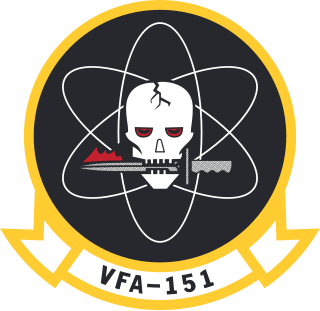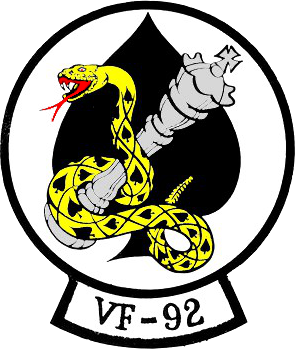
The Vought F4U Corsair is an American fighter aircraft that saw service primarily in World War II and the Korean War. Designed and initially manufactured by Chance Vought, the Corsair was soon in great demand; additional production contracts were given to Goodyear, whose Corsairs were designated FG, and Brewster, designated F3A.

Fighter Squadron 61 (VF-61), the Jolly Rogers, was a fighter squadron of the United States Navy. Originally established as VF-17 on 1 January 1943, it was redesignated as VF-5B on 15 November 1946, redesignated as VF-61 on 28 July 1948 it was disestablished on 15 April 1959. It was the first navy squadron to be designated VF-17.

Marine Fighter Attack Squadron 323 (VMFA-323) is an aircraft carrier-based aviation squadron of the United States Marine Corps. The squadron is equipped with the McDonnell Douglas F/A-18C Hornet and is based at Marine Corps Air Station Miramar, California, United States. It falls under the command of Marine Aircraft Group 11 (MAG-11) and the 3rd Marine Aircraft Wing but deploys with the U.S. Navy's Carrier Air Wing 17 (CVW-17). Their tail code is WS and their radio callsign is Snake.

Strike Fighter Squadron One Five One (VFA-151) nicknamed the Vigilantes are a United States Navy F/A-18E Super Hornet fighter squadron stationed at Naval Air Station Lemoore, California. The squadron is a part of Carrier Air Wing 9 (CVW-9). As part of CVW-9, the squadron's tail code is NG and its radio callsign is "Ugly".

Fighter Squadron 33 (VF-33) was an aviation unit of the United States Navy. Originally established on 11 October 1948 it was disestablished on 1 October 1993. It was the second U.S. Navy squadron to be designated VF-33.

VF-74, Fighter Squadron 74, Be-Devilers was an aviation unit of the United States Navy in service from 1944 to 1994. Originally established as VBF-20 on 16 April 1945, it was redesignated as VF-10A on 15 November 1946, redesignated as VF-92 on 12 August 1948, redesignated as VF-74 on 15 January 1950 and disestablished on 30 April 1994. It was the third US Navy squadron to be designated as VF-74.

Fighter Squadron 124 or VF-124Gunfighters was a fleet replacement squadron (FRS) of the United States Navy. Originally established on 16 August 1948 as VF-53, it was redesignated VF-124 at NAS Moffett Field on 11 April 1958 due to a need for an increased number of flight training squadrons, itself necessary because of introduction of swept wing fighters into Navy service. In 1961, the squadron relocated to NAS Miramar, California, which would become the U.S. Pacific Fleet's Master Jet Base for fighter aircraft.

Fighter Squadron 143 or VF-143 was an aviation unit of the United States Navy originally established as a Naval Reserve squadron VF-821 on 20 July 1950 it was redesignated VF-143 on 4 February 1953 and disestablished on 1 April 1958.

Strike Fighter Squadron 154 (VFA-154), also known as the "Black Knights", is a United States Navy strike fighter squadron stationed at Naval Air Station Lemoore. The Black Knights are an operational fleet squadron flying the F/A-18F Super Hornet. They are currently attached to Carrier Air Wing Eleven and deployed aboard the aircraft carrier USS Theodore Roosevelt. Their tailcode is NH and their callsign is "Knight".

Fighter Squadron 53, or VF-53Iron Angels was an aviation unit of the United States Navy in service from 20 July 1950 to 29 January 1971. Originally established as reserve squadron VF-721 on 20 July 1950, it was redesignated as VF-141 on 4 February 1953 and then redesignated as VF-53 on 15 October 1963. The squadron was disestablished on 29 January 1971. It was the fourth US Navy squadron to be designated as VF-53.

Strike Fighter Squadron 192 (VFA-192), also known as the "World Famous Golden Dragons", are a United States Navy F/A-18E Super Hornet fighter squadron stationed at NAS Lemoore.

VA-106 was an Attack Squadron of the U.S. Navy. Originally established as Bomber-Fighter Squadron Seventeen (VBF-17) on 2 January 1945, it was redesignated Fighter Squadron Six B (VF-6B) on 15 November 1946, redesignated VF-62 on 28 July 1948, redesignated Attack Squadron 106 (VA-106) on 1 July 1955, it was disestablished on 7 November 1969. It was the second US Navy squadron to be designated VA-106.

Fighter Squadron 92, or VF-92Silver Kings was an aviation unit of the United States Navy. Originally established as VF-92 on 26 March 1952, it was redesignated VF-54 on 1 June 1962, redesignated VF-92 on 15 October 1963, it was disestablished on 12 December 1975. It was the third US Navy squadron to be designated VF-92.

VA-44, nicknamed the Hornets, was an Attack Squadron of the US Navy. The squadron was established as Fighter Squadron VF-44 on 1 September 1950, and redesignated VA-44 on 1 January 1956. It was disestablished on 1 May 1970. It was the second squadron to be designated VA-44, the first VA-44 was disestablished on 8 June 1950.

Attack Squadron TWELVE, also known as the "Flying Ubangis" or "Clinchers", was an attack squadron of the United States Navy active during the Cold War. From their home port at Naval Air Station Cecil Field in Florida, the squadron made more than thirty major overseas deployments aboard aircraft carriers, primarily flying A-4 Skyhawk and later the A-7E Corsair II, including two combat tours in the Vietnam War.

Fighter Squadron 96, or VF-96Fighting Falcons was an aviation unit of the United States Navy in service from 1962 to 1975. When assigned to Carrier Air Wing Nine (CVW-9) their tailcode was NG, and their radio callsign was Showtime. Originally established as United States Naval Reserve squadron VF-791Fighting Falcons on 20 July 1950 it was redesignated VF-142 after becoming a regular squadron on 4 February 1953. It was re-designated VF-96 on 1 June 1962 and disestablished on 1 December 1975.

Fighter Squadron 52 or VF-52 was an aviation unit of the United States Navy. Originally established as Bombing Fighting Squadron 5 (VBF-5) on 8 May 1945, it was redesignated Fighting Squadron 6A (VF-6A) on 15 November 1946, redesignated as Fighter Squadron 52 (VF-52) on 16 August 1948 it was disestablished on 23 February 1959. It was the third US Navy squadron to be designated as VF-52.
Fighter Squadron 122 or VF-122 was an aviation unit of the United States Navy. Originally established as Reserve Squadron 783 (VF-783) it was called to active duty on 2 August 1950, it was re-designated VF-122 on 4 February 1953 and disestablished on 10 April 1958.

Fighter Squadron 22 or VF-22 was an aviation unit of the United States Navy. Originally established as Bombing Fighting Squadron 74A (VBF-74A) on 1 May 1945, it was redesignated VBF-74 on 1 August 1945, redesignated as VF-2B on 15 November 1946, redesignated as VF-22 on 1 September 1948, it was disestablished on 6 June 1958.

Fighter Squadron 82 or VF-82 was an aviation unit of the United States Navy. Originally established as Reserve Squadron VF-742 it was called to active duty during World War II and later recalled on 2 February 1951, redesignated VF-82 on 4 February 1953, it was disestablished on 15 April 1959. It was the third US Navy squadron to be designated VF-82.























